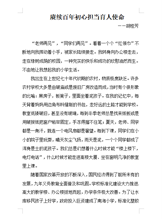while的用法知多少
while 的用法知多少?快来一起学习吧。下面小编就和大家分享,来欣赏一下吧。
while 的用法知多少?
今天有同学问我 while 怎么一会儿可以解释为“虽然”,一会可以解释为“当...的时候”,感觉到用不好它。
确实,while 是一个用法特别灵活的词,有很多词性,特别是做连词的时候,用法多样。我索性整理了一下 while 的全部用法,跟大家分享,希望大家不仅看得懂,自己同时会用出来。
一、while做名词,表示“一会儿”。
1)After lunch, she likes to take a nap for a while.
她喜欢午饭后眯一会儿。
2)It takes a while to adapt to a new environment.
适应新环境需要花一段时间。
二、while 做连词。
1. 引导时间状语,解释为“当...的时候”。
1)We must strike while the iron is hot.
趁热打铁。(我们必须当铁热的时候去击打它。)
2)While he is speaking, he does a lot of gestures.
他演讲的时候有很多手势。
2. 引导让步状语从句,意思是“虽然…但是…”。
.种情况,while 多放于句首
1)While there was no conclusive evidence, most people thought he was guilty.
虽然没有确凿的证据,大多数人还是认为他有罪。
2)While my heart is willing, my flesh is weak.
心有余而力不足。(虽然我的心是愿意的,但是我的肉体是虚弱的)。
3. 引导条件状语,意思是“只要”.
1)While there is life there is hope.
留得青山在,不怕没柴烧。(只要有命在,就有希望。)
2)While there is a will, there is a way.
有志者事竟成。(只要有意志力,就有道路。)
4. While 作并列连词用,意为“然而”,表对比关系。而but表转折。
.注意体会下列例句中 while 与 but 的区别:
1)Some people waste food while others haven't enough.
有些人很费粮食,然而有些人却吃不饱。
2)The son was having a good meal at home, while the parents were working in the fields.
儿子在家吃好饭而父母却在田里辛勤劳作。
3)I ought to have helped her, but I never could.
我本该帮她但没能。
4)Honey is sweet, but the bee stings.
蜂蜜很甜,但蜜蜂有刺蜇人。
情态动词——need的用法
“need”作为实义动词时,通常用法是
人+need +to do 物+need +doing 物+need +to be done 例如: The room needs cleaning = The room needs to be cleaned. 房间需要打扫了. 另外,“need”作实义动词时后还可以直接跟名词.请看下面的例子: It is a question that needs very careful consideration.这是一个需要慎重考虑的问题 很简单的方法区别情态动词与实义动词:当need为情态动词时,意思是“必要”,否定为"needn't",后面大多接动名词,表示动作; 当need为实义动词时,意思是“需要”,否定为"don't need",后面大多跟名词.
作情态动词
1.need作情态动词无人称或数的变化, 后接动词原形,多用于否定句和疑问句中.如:You needn't worry.你不必担心.
2.由need引出的一般疑问句,肯定回答常用must或have to;否定答语常用needn't. 如:
—Need I answer the question? 我需要回答那个问题吗?
—Yes, you must. /Yes, you have to.是的,你必须回答./是的,你得回答./No, you needn't.不,不必了.
3.由must引出的一般疑问句,肯定回答用must,否定答语用needn't或don't have to.如:
—Must I do the work now? 我必须现在干这个活吗?
—Yes, you must /have to.是的,你必须做./No, you needn't /don't have to. 不,你现在不必做.
Not only,but also 用法小结
not only和but also是并列连词,其要接并列结构或者说平行结构。not only后面的结构与but also后面的结构要对称,比如,两者后面接的都是名词、形容词、动词、介词、短语或者都是句子。
① 连接名词、形容词、介词
1 She is not only a singer but also an actress.
她不仅是个歌手,而且是个演员。
2 Before he was six, he played not only the piano but also the violin.
六岁之前,他不仅会弹钢琴,还精通小提琴。(外研社初中英语)
3 You are not only brave, but also very beautiful.
你不但勇敢而且非常美丽。
3 Carelessness will be a disaster not only to ourselves but also to patients.
粗心大意不仅对我们自己而且对病人都是一场灾难。
② 连接动词
1 It not only disturbs others but also does great harm to people’s hearing.
不仅会打扰别人也会对听力有影响。(仁爱初中英语)
2 John not only likes English, but also speaks it very well.
约翰不仅喜欢英语,而且英语说得很好。
3 She not only plays the piano,but also the violin.
她不仅弹钢琴,还拉小提琴。
4 Dear friends, please actively take part in after-class activities, which will not only make your school life colorful, but also improve your learning.
亲爱的朋友们,请积极参加课外活动,这不仅会使你的学校生活多姿多彩,而且会提高你的学习能力。
5 The report has not only attracted much attention but also some sharp criticism. (朗文英英词典)
这份报告不仅引起了人们的注意,而且还受到了一些尖锐的批评。
注意:连接不同的动词不可以省略,相同的动词可以省略。
③ not only在句首,句子要用部分倒装;but also后面也必须是句子
1 Not only did he make a promise, but also he kept it.
他不仅许下了诺言,而且还信守了诺言。
2 Not only is riding a bicycle beneficial to our health, but it is also a good way to solve traffic problems. (11江西书面表达) 骑自行车不仅有益于我们的健康,而且是解决交通问题的好方法。
④ not only … but also 中的 not only 不能分开使用,但 but also 却可以分开使用。
not only … but also 连接两个并列成分时,可以省略 but 或 also ,也可以把 but also 都省略掉。
1 Not only does he teach English but he teaches how to learn English well.
他不仅教英语,而且教如何学好英语。
2 Not only was I tired, I was also cold.
3 She not only finished the task ahead of time, she came to help us.
prefer的五种用法
1.prefer+名词 可以是某人或者某物,更喜欢某人或某物。
2.prefer A to B相比较B来说更喜欢A,A、B是某人或某物。
3.prefer doing sth 更喜欢做某事,宁愿做某事。
4.prefer doing sth to doing sth 想比较做某事来说更喜欢做某事。注意:相比较做后面那件事来说更喜欢做前面那件事。
5.prefer to do sth rather than do sth 相比较做某事来说更喜欢做某事。注意:想比较做后面那件事来说更喜欢做前面那件事,和第四句的意思一样,主要是需要注意两个动词的形式前后保持一致。
2基本字义prefer
英[prɪ'fɜː] 美[prɪ'fɝ]
vt.更喜欢;提升,提拔;给予(债权人)优先权;提出(控告)
vi.更喜欢,宁愿
第三人称单数现在时:prefers
现在分词:preferring
过去分词:preferred
过去时:preferred
同义词:like better;promote
【初二英语】之enough的用法
enough的用法
方法总结
1. enough修饰形容词时,形容词前置。
2. enough修饰名词时,名词后置。
例:当我们表达一个人很富有的时候,可以说rich enough, 也可以说He has enough money.
典型例题
— How do you like the talk show?
— I think it’s _______ , but some people think it’s so _______ .
A. wonderful enough; bored
B. enough wonderful; boring
C. wonderful enough; boring
【答案】C
【解析】第一步:看选项;
第二步:wonderful为形容词,极好的;
第三步:遇到enough形容词要前置,排除B;
第四步:第二空要表达“脱口秀使人感到无聊“,故答案为C.
小试身手
--How were the stores?
--They were _______ but I don’t have ________.
A. expensive; enough money
B. delicious; enough money
C. expensive; money enough

